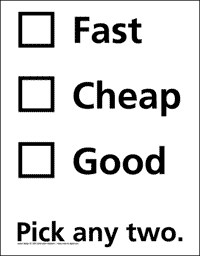The Importance of a Credible and Competent Valuation Expert
 The need for business valuation arises in many circumstances ranging from dispute resolution, to estate planning, to the sale of a business to name only a few. As in all professional disciplines, it is important to hire a practitioner who is fully trained, able to discern relevant facts, and abreast of current best practices. Consider the following New York Supreme Court case.*
The need for business valuation arises in many circumstances ranging from dispute resolution, to estate planning, to the sale of a business to name only a few. As in all professional disciplines, it is important to hire a practitioner who is fully trained, able to discern relevant facts, and abreast of current best practices. Consider the following New York Supreme Court case.*
Adelstein v. Finest Food Distributing Co
Two brothers and their uncle each owned a one-third interest in a distribution business. The brothers had offered to buy out the uncle. The uncle refused, the relationship deteriorated, and the case became a matter for the New York courts to decide.
The Brothers’ Expert
The expert for the brothers was a CPA lacking a business valuation credential, who had reportedly performed about 50 business valuations. His valuation report was three pages in length, based on a review of the company’s tax returns, and conversations with its accountant and its principals. He chose an income approach, using the capitalized income method. His rationale for using just one approach was that he couldn’t find comparable market transactions and that the company was not public. Normalizing adjustments produced an income stream of $206,000. A derived 20% capitalization rate was based upon company-specific risk factors such as customer concentration and limited management; applied a 20% discount for lack of marketability. He concluded the uncle’s one-third interest was worth $230,000.
The Uncle’s Expert
The uncle’s expert was a credentialed business appraiser. His review included tax returns, general ledger, bank statements, and sales reports. He found sales had doubled, gross margin declined, while officer compensation increased from $0 to $500,000. Further due diligence revealed 20% of sales were cash payments not recorded on the books. Analysis of sales reports found unrecorded sales of almost $1 million. Additionally, he imputed industry gross margins of 35% versus 25% company reported margins. The income approach produced a normalized income stream of $486,000, a 12% capitalization rate, a 5% discount, and a $4,050,000 value. As a sanity check, he applied a market approach using transaction data commonly accessed by professional business appraisers. In applying market multiples for sales, gross profit, and EBITDA he found a range of values between $3,990,000 and $4,191,000. He gave a 70% weight to the income derived value; 10% weight to each market derived value. He concluded the uncle’s one-third interest was worth $1,287,000.
The Court’s Decision
The court affirmed the uncle’s expert citing his “credibility and reliability of valuation methods.” Specifically, the court noted his qualifications, the use of more than one valuation method, and more objective and rigorous due diligence to support his conclusion. Importantly, the uncle’s expert also demonstrated an understanding of state law on the applicability of minority discounts.
This case illustrates the wide range of business valuations and experts found out there in the real world. More often than not, relying on a cursory review of an entity’s operations and a single method of valuation will omit key value determinants.
Accurate valuation requires an understanding of professional valuation standards and a rigorous analytical process that can be clearly explained and understood. Whatever the intended use of a business valuation, working with a trustworthy, experienced and accredited valuation professional usually provides the most accurate and defensible result.
* Adelstein v. Finest Food Distributing Co., 2014 N.Y. App. Div. LEXIS 2542 (April 16, 2014); Matter of Adelstein v. Finest Food Distributing Co., 2011 N.Y. LEXIS 5956 (Nov. 3, 2011)
Exit Strategies’ team of accredited business valuation experts have over 100 years of combined experience. Please contact us for a frank, confidential discussion about a potential business valuation, sale, merger or valuation need.

 I came across an article in the First Tuesday Journal, posted by Jeffery Marino, May 30, 2014, that I thought would be worth sharing. The author quotes two thinkers on the economics of bubble-and-bust episodes; Atif Mian, Economics Professor at Princeton and Amir Sufi, Finance Professor at the University of Chicago.
I came across an article in the First Tuesday Journal, posted by Jeffery Marino, May 30, 2014, that I thought would be worth sharing. The author quotes two thinkers on the economics of bubble-and-bust episodes; Atif Mian, Economics Professor at Princeton and Amir Sufi, Finance Professor at the University of Chicago.
 A new
A new 

